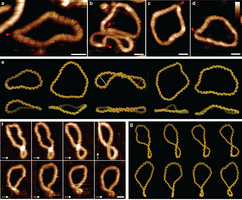CeNS Colloquium
Webinar
Date: 11.06.2021, Time: 15:30h
Visualising supercoiled DNA structure and interactions with base-pair resolution
Dr. Alice Pyne, The University of Sheffield
Understanding how DNA behaves in its cellular environment is a challenge of complexity, which can be enhanced by a better understanding of the fun damental properties of DNA. In the cell, DNA is arranged into highly-organised and topologically-constrained (supercoiled) structures. It remains unclear how this supercoiling affects the double-helical structure of DNA, largely because of limitations in spatial resolution of the available biophysical tools. We overcome these limitations by combining high-resolution AFM1 and atomistic MD simulations to resolve the structure, conformation and dynamics of supercoiled DNA to the base-pair level (Figure 1)2.
We use DNA minicircles, only twice the persistence length of DNA, to probe the structure and function of negatively-supercoiled DNA. These minicircles are small enough to be simulated at the atomistic level by MD and to be visualized at high (double-helix) resolution by AFM experiments in solution. We observe that negative superhelical stress induces local variation in the canonical B-form DNA structure by introducing kinks and defects that affect global minicircle structure and flexibility3. We probe how these local and global conformational changes affect DNA interactions such as the binding of triplex-forming oligonucleotides. Our results provide mechanistic insight into how DNA supercoiling can affect molecular recognition, that may have broader implications for DNA interactions with other molecular species.
References:
1. Pyne, A., Thompson, R., Leung, C., Roy, D. & Hoogenboom, B. W. Single-Molecule Reconstruction of Oligonucleotide Secondary Structure by Atomic Force Microscopy. Small 10, 3257–3261 (2014).
2. Pyne, A. L. B. et al. Base-pair resolution analysis of the effect of supercoiling on DNA flexibility and major groove recognition by triplex-forming oligonucleotides. Nature Communications 12, 1053 (2021).
3. Beton, J. G. et al. TopoStats – A program for automated tracing of biomolecules from AFM images. Methods (2021) doi:10.1016/j.ymeth.2021.01.008.


